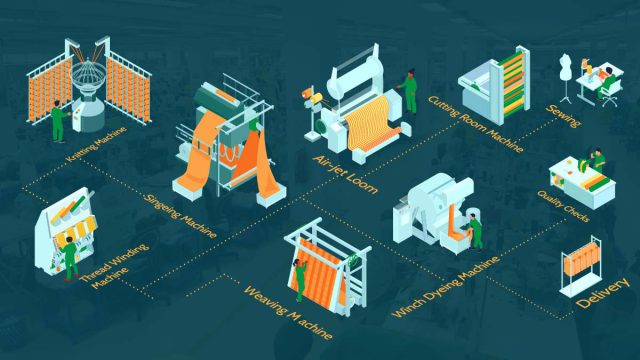The Bangladesh Textile Industry stands as a dynamic and rapidly growing sector with a rich history of textile production. Its significance in the global market cannot be overstated, as over 80% of the country’s total exports can be attributed to this industry. This article delves into the comprehensive landscape of the Bangladesh Textile Industry, highlighting its unique strengths, existing challenges, and promising prospects.
Global Impact of Bangladesh’s Garment Sector
A substantial portion of Bangladesh’s economy is bolstered by its garment sector, accounting for a staggering 80% of the nation’s total exports. This industry has transformed Bangladesh into a hub for global fashion brands, benefiting from low-cost, labor-intensive garment production. This advantageous position results from its economical labor force, duty-free access to key markets, and a growing pool of skilled workers.
Nevertheless, Bangladesh’s garment sector has faced challenges in maintaining its competitive edge on the global stage. The emergence of new low-cost production centers in countries like Vietnam and Cambodia has compelled Bangladesh to enhance its working conditions, raise wages, and boost efficiency. In response to tragedies such as the Rana Plaza disaster in 2013, international organizations and brands have initiated efforts to improve working conditions and safety standards, emphasizing the need for continuous growth and betterment in this sector.
In-Depth Analysis of Bangladesh’s Textile Manufacturing Market
The Bangladesh Textile Industry is a cornerstone of the nation’s economy, generating a remarkable 80% of its total exports and providing employment for millions. This industry is renowned for its diverse textile offerings, encompassing cotton and synthetic fabrics, readymade garments, and home textiles. A comprehensive breakdown of the Bangladesh Textile Manufacturing Market follows:
Market Size and Growth: In recent years, the industry has exhibited impressive growth, with an estimated worth of $40 billion in 2021. This growth, averaging around 10% annually, is attributed to the escalating demand for Bangladesh’s textiles both within domestic and international markets.
Skilled Labor Force: A well-trained workforce is central to Bangladesh’s textile industry. The government’s substantial investments in vocational training and education ensure a steady supply of skilled and unskilled workers.
Government Support: The textile industry enjoys the backing of Bangladesh’s government, which has implemented favorable trade policies and incentives to attract foreign investment. The Bangladesh Investment Development Authority (BIDA) has played a pivotal role in drawing international investment into the sector.
Product Range: With a rich history that spans centuries, Bangladesh is recognized for producing a wide spectrum of textiles, from cotton and synthetic fabrics to readymade garments and home textiles.
Challenges: Despite its successes, the industry confronts challenges including power shortages, inadequate infrastructure, and low productivity. Fierce competition from other textile-producing nations necessitates consistent innovation for sustained competitiveness.
Future Prospects: Despite hurdles, the Bangladesh Textile Industry’s future appears promising. Industry leaders and the government are investing in modernizing the sector. A strategic geographical location and a well-developed transportation network make Bangladesh an attractive investment destination. Furthermore, the burgeoning demand for sustainable and ethical clothing is projected to drive continued growth.
Competitive Landscape and Players
Bangladesh’s textile manufacturing market contends with formidable competition from low-cost production centers like China, India, Vietnam, and others. Factors like labor costs, infrastructure, and production efficiency influence its competitiveness. Bangladesh maintains a labor cost advantage but faces challenges in infrastructure development and ensuring labor welfare.
Top competitors include China, India, Vietnam, Cambodia, Turkey, Indonesia, Thailand, Pakistan, Sri Lanka, and Mexico. These countries vie with Bangladesh due to low labor costs, trade agreements, and access to global markets.
Key players in Bangladesh’s textile manufacturing market include Grameen Knitwear, BEXIMCO, Ananta Group, Ha-Meem Group, Square Textiles, and others. These businesses wield substantial influence, not only domestically but internationally, and actively contribute to elevating the industry’s profile.
Displacement of Production and Industry Developments
Displacement of production, evident in the garment industry’s shift from developed to developing countries, has significantly impacted global economies. Factors such as low labor costs, favorable business environments, and access to raw materials drive this shift. Developed nations grapple with job loss and reduced economic activity while developing countries face the challenges of substandard working conditions and exploitation.
Solutions require collaboration among stakeholders. Developed nations should create new industries while developing countries need to enhance labor protections and working conditions. Multinational corporations must prioritize fair treatment of workers.
In recent years, Bangladesh’s textile industry has witnessed substantial advancements, including technology investments, a sustainability focus, infrastructure enhancements, and a growing international presence. These developments reflect the industry’s commitment to efficiency, sustainability, and global competitiveness.
Epilogue
The Bangladesh Textile Industry’s journey from a historical legacy to a global powerhouse is marked by its significant contributions to the nation’s economy. A labor force with skill diversity, government support, and a diverse product range defines its strengths. Challenges encompass infrastructural limitations and intense competition. Yet, with strategic investments and a commitment to ethical and sustainable practices, Bangladesh’s textile industry is poised to remain a pivotal player in the global market, supporting economic growth and creating a dynamic future.
Here are some links for our readers with valuable perspectives from reputable sources that support and expand on the ideas discussed in this article. Explore and enrich yourself.
- World Trade Organization – Textiles and Clothing
- The Financial Express – Bangladesh Textile Industry News
- Accord on Fire and Building Safety in Bangladesh
- Bangladesh Investment Development Authority (BIDA)
- United Nations Industrial Development Organization – Textile Industry
Read more write-ups of this author: Click Here

About The Author:
Mirza Rakib Hasan Shovon
Managing Director and CEO
Aristo Tex International
Technet Corporation
ANYVAS
Director
Research & Development
International Corporate Association of Professionals (InCAP)


















